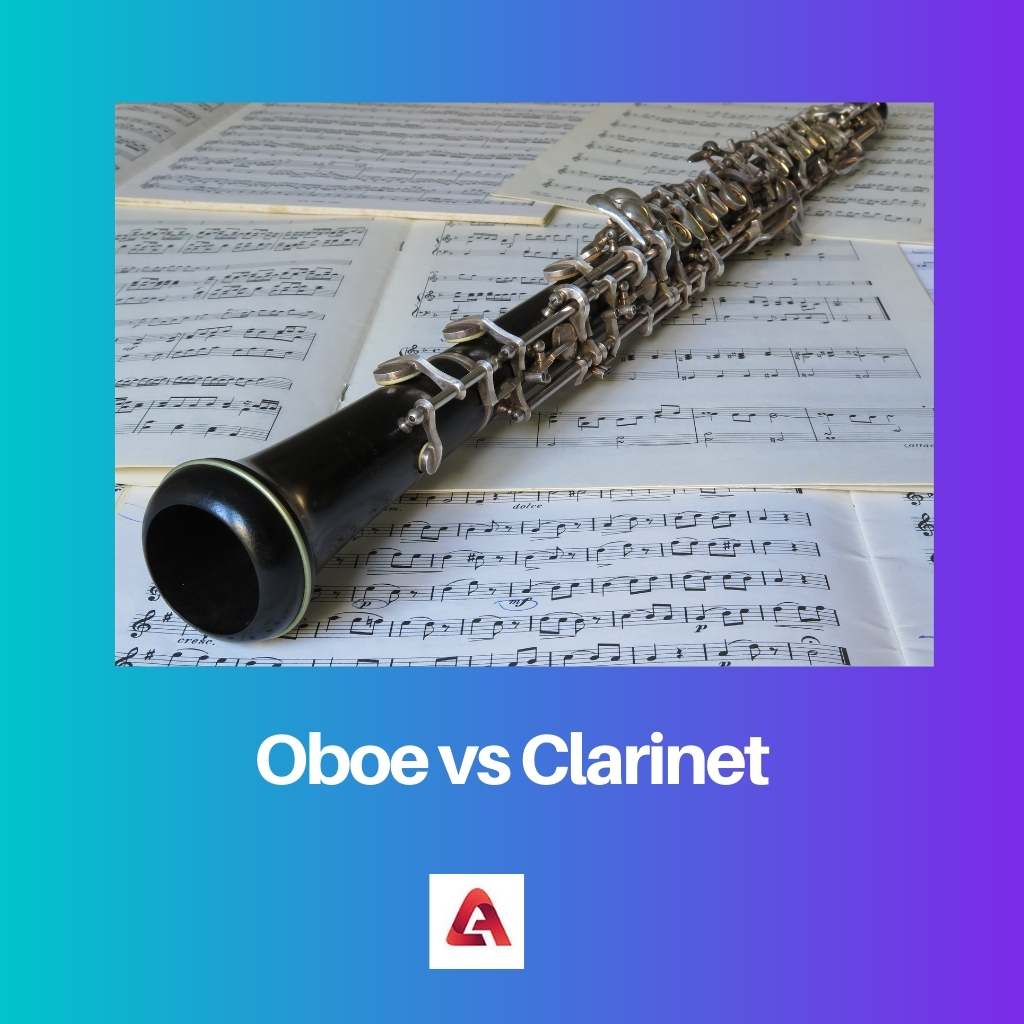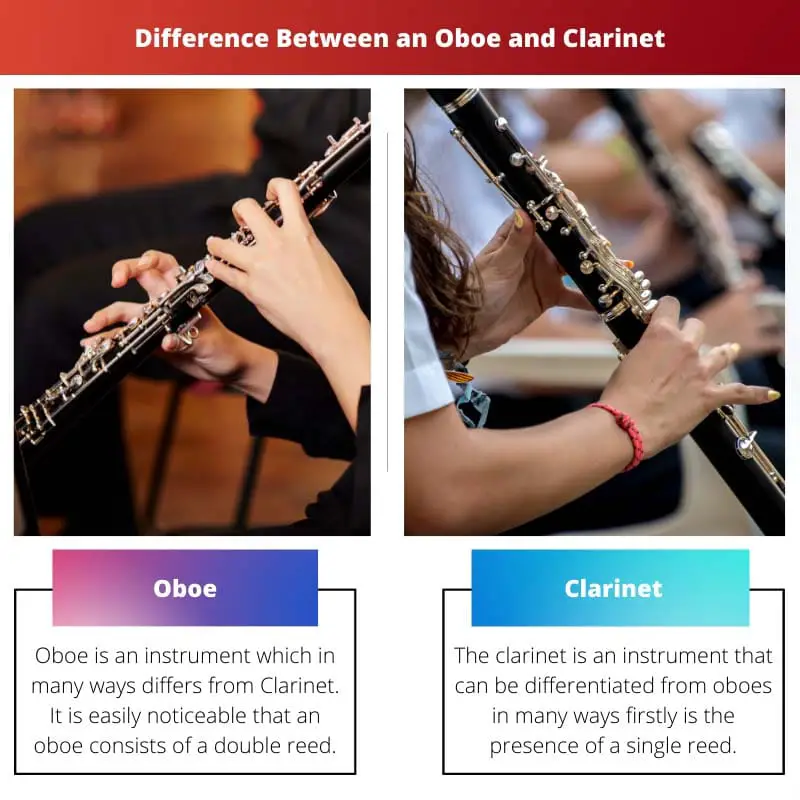Oboe and Clarinet are terms that can be said to be very confusingly similar as well as different. The biggest difference between these two can be pointed out in the number of reeds.
Oboe is an instrument with two reeds; on the other hand, we have a Clarinet with a single reed.
Oboe is an instrument made out of wood, and the wind is used to blow through this instrument in order to play it. This woodwind instrument consists of a double reed mouthpiece, making it unique from Clarinet.
This instrument mainly came to the front around the 18th century from French culture or Italian culture.
A clarinet is an instrument also made out of wood, and the wind is used to play this, but this instrument has only a single reed. This feature of a single-reed mouthpiece makes it unique and different from the Clarinet.
This instrument came into notice around the 18th century as well but with no doubt from the French culture.
Key Takeaways
- The oboe is a double-reed woodwind instrument with a conical bore, while the clarinet is a single-reed instrument with a cylindrical bore.
- Oboes produce a penetrating and nasal sound, while clarinets have a warm and rich tone.
- The oboe is more challenging to play due to its double-reed mechanism and fingerings, while the clarinet is easier to learn and master.
Oboe vs Clarinet
The difference between Oboe and Clarinet is that Oboe is a slender tubular body while on the other hand, Clarinet is a cylindrical tube when it comes to body structure. Oboe and Clarinet are though two same kinds of looking instruments but still consist of many minutes and even big differences.

Oboe first is believed to have appeared in the 17th century France nobody knows the exact origin of this instrument. The initial stage of an oboe started with a feature of three keys and was built from boxwood.
The contemporary oboes are made from mainly African blackwood and from rosewood or cocobolo as well.
Clarinet first is believed to have appeared in France or Italy and was evolved from single-reed instruments like Albogue or Alboka.
But every modern Clarinet is believed to have evolved from chalumeau. These instruments are made from African Blackwood or Grenadilla or rosewood or, very rare from cocobolo.
Comparison Table
| Parameters of Comparison | Oboe | Clarinet |
|---|---|---|
| Bore | Conical bore | Cylindrical bore |
| Bell | Round Bell | Flared Bell |
| Tone Holes | Mostly consists of closed tone holes | Mostly consists of open tones |
| Length | 26 inches | 27.6 inches |
| Unique parts | Staple and a reed | Barrel and mouthpiece |
What is an Oboe?
Oboe is an instrument that in many ways differs from Clarinet. It is easily noticeable that an oboe consists of a double reed. These two reed works side by side in order to produce sound.
This difference in placement of the reed makes all differences in tones, and we as makes it unique and different from a clarinet.
Oboe can produce a very broad range of tones, making it very valuable in genres like jazz. Its conical bore is the reason for forming such a bright tone which makes it much more valuable.
Along with this different range of tones, this instrument is capable of forming soft tones as well.
Oboe is much more difficult to learn if we compare it to Clarinet and also need professional help to learn to play this instrument. Oboes are even limited in types, unlike Clarinet.
There are mainly three types of Oboes which include Cor Anglais, Oboe d’amore, and lastly bass oboe.
Cor Anglais consists of a special feature of an F pitch, Oboe d’amore consists of an A pitch, and lastly, bass oboe comes specially with one octave sound lower than naturally used in oboes.
Some of the famous musicians who use oboes are Walter Boeykens, Naftule Brandwein, etc.

What is a Clarinet?
The clarinet is an instrument that can be differentiated from oboes in many ways first is the presence of a single reed. It consists of a barrel and a mouthpiece.
The single reed is placed on the mouthpiece, which with the help of a ligature, is kept in a particular place.
The tone of a clarinet can differ from the oboe in the way because it has a distinctive timbre. There are mainly three different kinds of tones i.e. the chalumeau or low, clarion or clarino or middle, and lastly, altissimo or high.
The clarinet mainly sounds a little dark, and rich, and moreover, the bass clarinet sounds very deep and mellow in nature.
In a modern clarinet, we can find numerous keys and seven-hole (one in the back and six in front), which have complex functions as well. But if we compare the learning process of the clarinet, it is much easier than an oboe.
When we talk about types of clarinet, there are many and changes based on the combination of instruments and occasions for example Piccolo is a rare kind of clarinet that is mainly used in Italian military music, and the Sopranino kind of clarinet is used in a very wide range of music.

Main Differences Between Oboe and Clarinet
- Oboe is an instrument that has a very wide range of tones, while the Clarinet, on the other hand, is used for a little dark sound.
- Oboes have an amplified and bright sound, while Clarinet, on the other hand, has a mellow and round sound.
- Oboe is an instrument that is shorter than the Clarinet by 1.6 inches.
- Obes are hard to learn and cannot be learned without the help of professional teachers, while Clarinet, on the other hand, is easy to learn when we compare.
- Oboes have a conical bore, while on the other hand, Clarinet has a cylindrical or reverse cylindrical bore.
- Oboe has much more restrictions when we talk about range, while on the other hand, the Clarinet is famous for its highest range in the whole woodwind family.
- Oboe is used in pieces of music like classical and baroque, while Clarinet is used in jazz, classical, folk, and even romantic.

- https://www.jstor.org/stable/3679606
- https://journals.sagepub.com/doi/abs/10.2307/3344680
- https://asa.scitation.org/doi/abs/10.1121/1.1919317